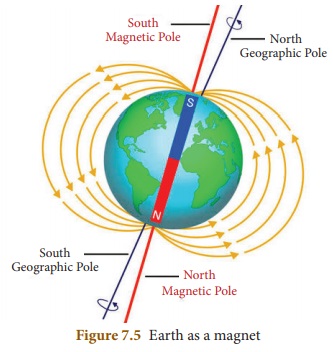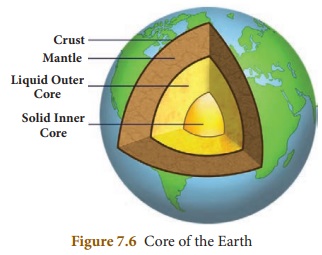Magnetism | Chapter 7 | 8th Science - Earth’s Magnetism | 8th Science : Chapter 7 : Magnetism
Chapter: 8th Science : Chapter 7 : Magnetism
Earth’s Magnetism
Earth’s Magnetism
Earth has been assumed or imagined
by the scientists as a huge magnetic dipole. However, the position of the
Earth’s magnetic poles is not South Geographic Pole North Magnetic Pole well defined
in the Earth. The south pole of the imaginary magnet inside the Earth is
located near the geographic north pole and the north pole of the earth’s magnet
is located near the geographic south pole. The line joining these magnetic
poles is called the magnetic axis.
The magnetic axis intersects the
geographic north pole at a point called the north geomagnetic pole or northern
magnetic pole. It intersects the geographic south pole at a point called the
south geomagnetic pole or southern magnetic pole.
The most powerful magnet
in the universe is actually a neutron star called magnetar (magnetic neutron
star) located in the Milky Way Galaxy. The diameter of the magnetar is 20
kilometer and its mass is 2 to 3 times that of the Sun. Its magnetic field is
so enormous and lethal that it is capable of absorbing all the iron atoms from
the bloodstream (hemoglobin) of a living body even if it is positioned at a
distance of 1000 km from it.
The magnetic axis and the
geographical axis (axis of rotation) do not coincide with each other. The
magnetic axis of the Earth is inclined at an angle of about 10° to 15° with the
geographical axis.

The exact cause of the Earth’s
magnetism is not known even today. However, some important factors, which may
be the cause of the Earth’s magnetism, are as follows.
* Masses of magnetic substances in
the Earth
* Radiations from the Sun
* Action of the Moon
However, it is believed that the
Earth’s magnetic field is due to the molten charged metallic fluid inside the
Earth’s surface with a core of radius of about 3500 km compared to the Earth’s
radius of 6400 km.

Pigeons have
extraordinary navigational abilities. It enables them to find their way back
home even if you take them to a place where they have never been before. The
presence of magnetite in their beaks enables them to sense the magnetic field
of the Earth. Such a magnetic sense is called magneto-reception.
Earth’s Magnetic Field
A freely suspended magnetic needle
at a point on the Earth comes to rest approximately along the geographical north
south direction. This shows that the Earth behaves like a huge magnetic dipole
with its magnetic poles located near its geographical poles. The north pole of
a magnetic needle approximately points towards the geographic north (NG). Thus,
it is appropriate to say that the magnetic north pole of the needle is
attracted by the magnetic south pole of the Earth (Sm), which is located at the
geographic north (NG). Also, the magnetic south pole of the needle is attracted
by the magnetic north pole of the Earth (Nm), which is located at the
geographic south (SG). The magnitude of the magnetic field strength at the
Earth’s surface ranges from 25 to 65 micro tesla.
Earth’s magnet is 20 times
more powerful than a fridge magnet.
Related Topics